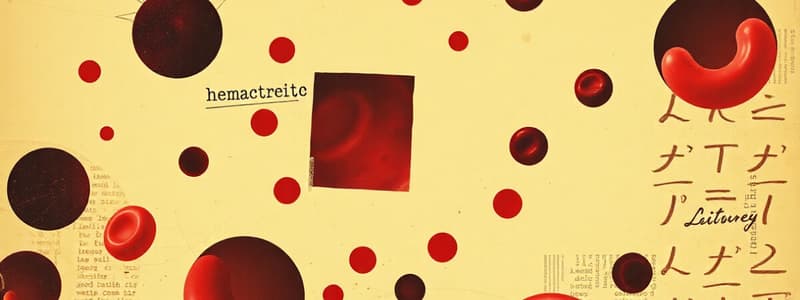Podcast
Questions and Answers
A patient with blood type A+ needs a blood transfusion. Which of the following blood types can they safely receive?
A patient with blood type A+ needs a blood transfusion. Which of the following blood types can they safely receive?
- B+, AB+
- A-, O- (correct)
- AB-, B-
- O+, B+
Erythropoietin (EPO) is released to stimulate red blood cell production. Which of the following scenarios would trigger the highest release of EPO?
Erythropoietin (EPO) is released to stimulate red blood cell production. Which of the following scenarios would trigger the highest release of EPO?
- Receiving a blood transfusion to treat anemia.
- Moving from sea level to a high-altitude environment. (correct)
- Increasing iron intake through diet and supplements.
- Maintaining a consistent exercise routine.
During the process of hemostasis, several stages occur to stop bleeding. Which of the following describes the primary role of platelets in this process?
During the process of hemostasis, several stages occur to stop bleeding. Which of the following describes the primary role of platelets in this process?
- Dissolving the blood clot once the vessel is repaired.
- Forming a temporary plug at the site of injury by adhering to the damaged vessel wall. (correct)
- Converting fibrinogen into fibrin to form a stable clot.
- Activating the intrinsic and extrinsic coagulation pathways.
Which of the following accurately describes the role and source of bile in digestion?
Which of the following accurately describes the role and source of bile in digestion?
A medication interferes with Vitamin K absorption in the small intestine. Which of the following processes would be most directly affected?
A medication interferes with Vitamin K absorption in the small intestine. Which of the following processes would be most directly affected?
Flashcards
Hematocrit
Hematocrit
The percentage of blood volume occupied by red blood cells.
Red Blood Cell (RBC)
Red Blood Cell (RBC)
Transports oxygen in blood; lacks a nucleus to maximize space for hemoglobin.
Erythropoietin
Erythropoietin
A hormone that stimulates red blood cell production in the bone marrow.
Mechanical vs. Chemical Digestion
Mechanical vs. Chemical Digestion
Signup and view all the flashcards
Function of Bile
Function of Bile
Signup and view all the flashcards
Study Notes
Blood Functions
- Transports oxygen, nutrients, hormones, and waste products.
- Regulates body temperature, pH, and fluid volume.
- Protects against infection and blood loss.
Plasma Components
- Plasma is the liquid component of blood.
- Functions of plasma include transporting blood cells, nutrients, and waste.
- Albumin is a plasma protein that helps maintain osmotic pressure and transports substances.
Hematocrit Definitions
- Hematocrit is the percentage of blood volume occupied by red blood cells.
- Clinical hematocrit measures the packed cell volume of red blood cells.
RBC Structure and Function
- Red blood cells (RBCs) carry oxygen.
- RBCs have a biconcave shape to increase surface area for gas exchange.
- RBCs lack a nucleus to maximize space for hemoglobin.
Hemoglobin Structure and Function
- Hemoglobin is a protein in RBCs that binds to oxygen.
- Hemoglobin consists of four polypeptide chains and heme groups containing iron.
Leukocytes and Their Functions
- Leukocytes are white blood cells involved in immune defense.
- Leukocytes include neutrophils, lymphocytes, monocytes, eosinophils, and basophils.
- Each type of leukocyte has a specific function in fighting infection and inflammation.
Erythropoietin Function
- Erythropoietin is a hormone that stimulates red blood cell production.
Cells Forming Megakaryocytes
- Megakaryocytes produce platelets.
Blood Types and Donors
- Blood types are determined by the presence or absence of antigens on red blood cells.
- Blood types include A, B, AB, and O.
- Different blood types can donate to and receive blood from specific other types.
Incompatible Blood Transfusion
- An incompatible blood transfusion occurs when the recipient's immune system attacks the donor's red blood cells.
Hemolytic Disease
- Hemolytic disease of the newborn can occur when an Rh-negative mother carries an Rh-positive fetus.
Platelets
- Platelets are involved in blood clotting
- Platelets adhere, activate, aggregate, and stabilize
Vitamin K Importance
- Vitamin K is important for blood clotting as it helps produce certain factors
Fibrinolysis
- Fibrinolysis is the breakdown of blood clots.
Final Stage of Clotting
- The final stage of clotting involves cross-linking fibrin to stabilize the clot.
Prostaglandin
- Prostaglandins are involved in inflammation and blood flow.
Sections of Digestion
- Ingestion, propulsion, mechanical breakdown, chemical digestion, absorption, and defecation constitute the process of digestion.
Mechanical and Chemical Digestion
- Mechanical digestion physically breaks down food (e.g., chewing).
- Chemical digestion uses enzymes to break down food molecules (e.g., saliva).
Organ Functions
- Organs involved in digestion include the mouth, esophagus, stomach, small intestine, large intestine, liver, gallbladder, and pancreas.
- Absorption of nutrients mainly occurs in the small intestine
Gallbladder, Liver, Pancreas
- The gallbladder stores and concentrates bile.
- The liver produces bile and metabolizes nutrients.
- The pancreas secretes digestive enzymes and hormones.
Bile and Epiglottis
- Bile emulsifies fats for digestion.
- The epiglottis prevents food from entering the trachea during swallowing.
Peristalsis
- Peristalsis is the wave-like muscle contractions that propel food through the digestive tract.
Digestive Hormones
- Digestive hormones regulate digestive processes.
Enzymes
- Enzymes aid in the digestion of fats, carbohydrates, and proteins.
Fat Soluble Absorption
- Fat-soluble vitamins are absorbed in the bloodstream.
- Intrinsic factor is required for vitamin B12 absorption.
Liver Blood Flow
- The hepatic artery supplies oxygenated blood to the liver.
Studying That Suits You
Use AI to generate personalized quizzes and flashcards to suit your learning preferences.
Related Documents
Description
Overview of blood composition, including plasma and hematocrit. Red blood cells (RBCs) structure, function, and hemoglobin are discussed. Functions of blood include transport, regulation, and protection.




